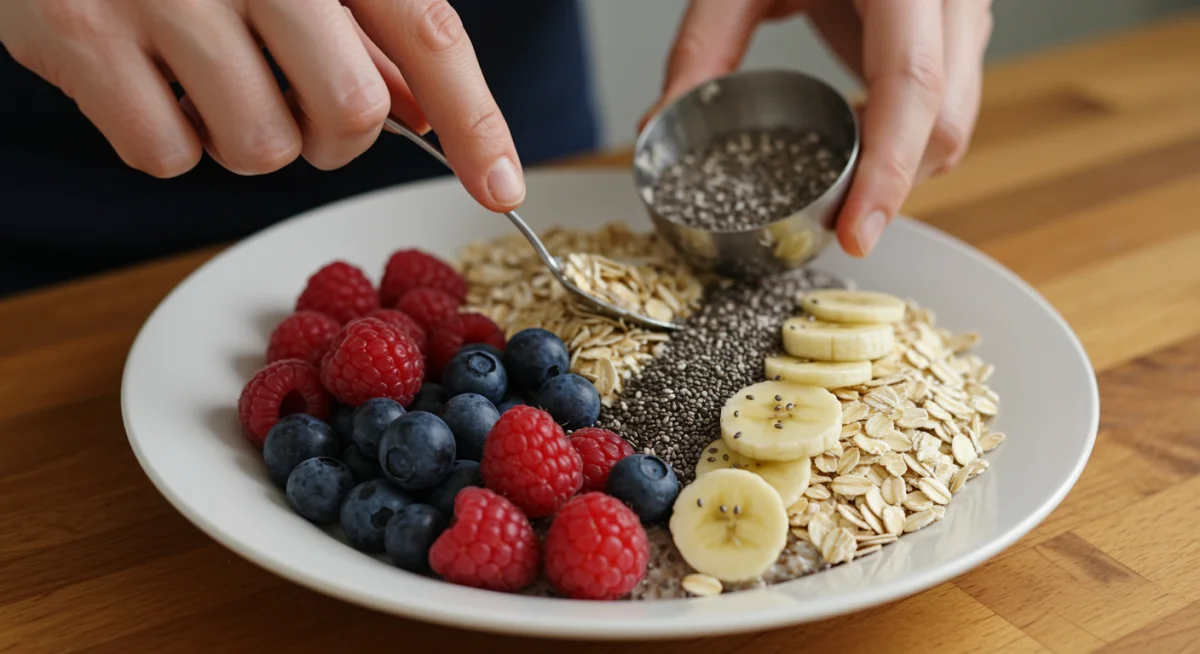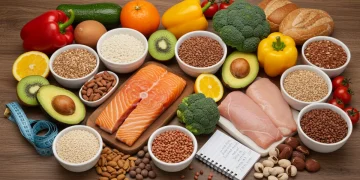Appetite Control: 7 Dietary Hacks to Reduce Cravings by 15%

Mastering appetite control is crucial for sustainable health, with effective dietary strategies proven to reduce cravings by 15% through scientific principles and practical application.
Understanding and implementing effective appetite control hacks is a game-changer for anyone aiming for better health and sustainable weight management. This article delves into the science behind curbing those insistent cravings, offering seven practical dietary strategies that can realistically reduce your desire to overeat by a significant 15%.
The Biological Basis of Hunger and Satiety
Our bodies are complex systems, constantly communicating through a network of hormones and neural signals to regulate hunger and fullness. This intricate dance dictates when we feel the urge to eat and when we are satisfied. Understanding these biological underpinnings is the first step toward effective appetite control.
Key hormones like ghrelin, often dubbed the “hunger hormone,” signal to the brain that it’s time to eat, while leptin, produced by fat cells, signals satiety, letting us know we’ve had enough. Disruptions in this delicate balance can lead to increased cravings and overeating, making it harder to maintain a healthy weight. Environmental factors, stress, and even sleep quality can significantly influence these hormonal signals, creating a complex interplay that affects our dietary choices.
The Role of Hormones in Appetite Regulation
Ghrelin levels typically rise before meals and decrease after eating, creating a natural ebb and flow of hunger. Leptin, on the other hand, works over a longer term, providing information about our body’s energy stores. When leptin levels are low, the brain interprets this as a signal that energy reserves are dwindling, prompting an increase in appetite. Conversely, higher leptin levels indicate sufficient energy stores, suppressing hunger.
- Ghrelin: Stimulates appetite, produced primarily in the stomach.
- Leptin: Suppresses appetite, produced by adipose tissue.
- Cholecystokinin (CCK): Promotes short-term satiety, released in the small intestine.
- Peptide YY (PYY): Reduces appetite, released in the ileum and colon.
Beyond these primary players, insulin, secreted by the pancreas, also plays a crucial role in glucose metabolism and can influence hunger and satiety. High insulin levels can sometimes lead to rebound hunger, especially after consuming high-sugar foods. The brain’s hypothalamus acts as the central command center, integrating all these hormonal messages to regulate our eating behavior.
In conclusion, effective appetite control begins with an appreciation of the sophisticated biological mechanisms governing hunger and satiety. By acknowledging the influence of hormones and neural pathways, we can better strategize our dietary choices to align with our body’s natural signals, rather than fighting against them.
Hack 1: Prioritize Protein at Every Meal
One of the most effective dietary strategies for curbing appetite and reducing cravings is to emphasize protein intake at every meal. Protein is renowned for its satiety-inducing properties, meaning it helps you feel fuller for longer, thereby naturally decreasing the likelihood of overeating.
When you consume protein, it triggers the release of specific hormones, such as PYY and GLP-1, which signal fullness to your brain. This hormonal response is more pronounced with protein compared to carbohydrates or fats. Furthermore, protein requires more energy to digest and metabolize, a phenomenon known as the thermic effect of food, which can also contribute to a slight increase in calorie expenditure.
Optimal Protein Sources and Timing
To maximize the benefits of protein for appetite control, focus on lean, high-quality sources. Integrating protein into breakfast is particularly impactful, as it sets the tone for satiety throughout the day and can prevent mid-morning snack attacks. Distributing protein evenly across all meals also helps maintain stable blood sugar levels, preventing the sharp dips that often trigger intense cravings.
- Breakfast: Eggs, Greek yogurt, protein smoothie, cottage cheese.
- Lunch: Chicken breast, fish, lentils, quinoa salad.
- Dinner: Lean beef, tofu, beans, turkey.
- Snacks: A handful of nuts, edamame, protein bar.
The goal is not simply to eat more protein, but to strategically incorporate it into your daily diet in a way that supports sustained fullness and reduces the desire for unhealthy snacks. Aim for approximately 20-30 grams of protein per main meal to achieve optimal satiety signals. This approach can lead to a significant reduction in overall calorie intake without feeling deprived.
In summary, making protein a cornerstone of your diet is a powerful and scientifically-backed method to enhance satiety and effectively manage cravings. By choosing the right sources and timing their consumption strategically, you can gain better control over your appetite.
Hack 2: Embrace Fiber-Rich Foods
Fiber is a non-digestible carbohydrate that plays a crucial role in promoting satiety and regulating appetite. Unlike other carbohydrates, fiber passes through your digestive system largely intact, adding bulk to your meals and slowing down digestion. This extended digestive process helps you feel full for longer and prevents rapid spikes and crashes in blood sugar levels, which are often culprits behind sudden cravings.
There are two main types of fiber: soluble and insoluble. Soluble fiber, found in foods like oats, beans, and fruits, forms a gel-like substance in water, which further slows digestion and nutrient absorption. Insoluble fiber, present in whole grains and vegetables, adds bulk to stool and promotes regular bowel movements. Both types contribute to overall digestive health and significant appetite suppression.
Incorporating More Fiber into Your Diet
Increasing your fiber intake doesn’t have to be complicated. Small, consistent changes can make a big difference. Start by swapping refined grains for whole grains, and make sure to include a variety of fruits and vegetables in every meal. Legumes, nuts, and seeds are also excellent sources of dietary fiber.
- Whole Grains: Opt for whole wheat bread, brown rice, oats, and quinoa.
- Fruits: Berries, apples, pears, and bananas are packed with fiber.
- Vegetables: Broccoli, spinach, carrots, and sweet potatoes are great choices.
- Legumes: Beans, lentils, and chickpeas are fiber powerhouses.

It’s important to increase fiber intake gradually to avoid digestive discomfort. Also, remember to drink plenty of water when consuming high-fiber foods, as fiber absorbs water and requires adequate hydration to move efficiently through the digestive system. This combination of fiber and water creates a powerful duo for sustained fullness.
Ultimately, making fiber a staple in your diet is a straightforward yet highly effective strategy for managing appetite and reducing cravings. By fostering a sense of fullness and stabilizing blood sugar, fiber helps you eat less naturally and more mindfully.
Hack 3: Stay Hydrated with Water
Often overlooked, proper hydration is a simple yet incredibly powerful tool in the arsenal of appetite control. Our bodies sometimes confuse thirst signals with hunger cues, leading us to reach for snacks when all we truly need is a glass of water. Drinking enough water can help differentiate between actual hunger and mere dehydration, preventing unnecessary calorie intake.
Water also contributes to a feeling of fullness. Consuming water before meals can take up space in your stomach, leading to reduced food intake during the meal. This simple pre-meal ritual can significantly impact your overall calorie consumption and help you feel satisfied with smaller portions.
Tips for Optimal Hydration
Making hydration a priority doesn’t have to be a chore. Integrating water into your daily routine can be simple and even enjoyable. Carrying a reusable water bottle, setting reminders, and infusing water with fruits or vegetables are easy ways to boost your fluid intake.
- Drink before meals: Have a glass of water 15-30 minutes before eating.
- Carry a water bottle: Keep it visible and accessible throughout the day.
- Infuse water: Add lemon, cucumber, or berries for flavor variety.
- Track your intake: Use an app or simply count your glasses.
Beyond appetite control, adequate hydration supports numerous bodily functions, including metabolism, nutrient transport, and temperature regulation. It’s a foundational element of overall health that directly impacts our ability to manage our weight and control cravings effectively. Don’t underestimate the power of a simple glass of water.
In conclusion, ensuring you are consistently well-hydrated is a fundamental, easy-to-implement strategy for appetite control. By distinguishing thirst from hunger and promoting a sense of fullness, water helps you make more conscious and healthier food choices.
Hack 4: Incorporate Healthy Fats
While often demonized, healthy fats are essential for satiety and overall health. Fats take longer to digest than carbohydrates and protein, contributing to a prolonged feeling of fullness and helping to stabilize blood sugar levels. This slow digestion prevents the rapid onset of hunger that often follows meals high in refined carbohydrates.
Not all fats are created equal. Focus on unsaturated fats, particularly monounsaturated and polyunsaturated fats, which are found in whole, unprocessed foods. These fats not only help with appetite control but also provide vital nutrients and support various bodily functions, including hormone production and cell health.
Best Sources of Satiating Healthy Fats
Integrating healthy fats into your diet can be delicious and satisfying. Avocado, nuts, seeds, and fatty fish are excellent sources that can be easily incorporated into meals and snacks. These foods provide a rich, satisfying element that can reduce the desire for less nutritious options.
- Avocado: Add to salads, sandwiches, or make guacamole.
- Nuts and Seeds: Almonds, walnuts, chia seeds, flaxseeds as snacks or toppings.
- Olive Oil: Use for dressings and cooking at moderate temperatures.
- Fatty Fish: Salmon, mackerel, and sardines are rich in Omega-3s.

Portion control is key when it comes to fats, as they are calorie-dense. While beneficial, consuming them in excess can lead to unwanted weight gain. The goal is to include just enough healthy fat to enhance satiety without significantly increasing your total caloric intake. A balanced approach ensures you reap the benefits without the drawbacks.
To summarize, strategic inclusion of healthy fats in your diet is a powerful hack for appetite control. They promote lasting fullness and help regulate blood sugar, making it easier to resist cravings and maintain a balanced eating pattern.
Hack 5: Practice Mindful Eating
Mindful eating is a practice that involves paying full attention to the experience of eating, including your body’s hunger and fullness cues, the flavors, textures, and aromas of your food. In our fast-paced world, many people eat quickly and mindlessly, often while distracted by screens or other tasks. This detachment can lead to overeating because the brain doesn’t register satiety signals effectively.
By slowing down and engaging all your senses, mindful eating allows you to truly savor your food and recognize when you’ve had enough. It’s not about strict rules or diets but about developing a healthier relationship with food and your body. This practice can significantly reduce cravings driven by emotional triggers or habitual eating.
Steps to Cultivate Mindful Eating Habits
Implementing mindful eating doesn’t require drastic changes; rather, it involves a shift in focus and awareness. Start with small steps and gradually incorporate these practices into your daily routine to experience their profound impact on appetite control.
- Eat slowly: Take smaller bites and chew thoroughly.
- Eliminate distractions: Turn off the TV, put away your phone.
- Listen to your body: Pay attention to hunger and fullness cues.
- Savor each bite: Notice the flavors, textures, and smells.
Mindful eating also involves acknowledging your emotions around food without judgment. Are you eating because you’re truly hungry, or are you seeking comfort, boredom relief, or stress reduction? Recognizing these patterns can empower you to address the root cause of your cravings rather than just suppressing them. It’s a holistic approach that fosters long-term behavioral change.
In essence, practicing mindful eating is a transformative hack for appetite control, shifting your focus from automatic consumption to conscious nourishment. This heightened awareness helps you better interpret your body’s signals and significantly reduce impulsive eating and cravings.
Hack 6: Manage Stress and Sleep Quality
While not directly dietary, stress levels and sleep quality profoundly impact appetite and cravings. Chronic stress can lead to elevated cortisol levels, a hormone that not only promotes fat storage but also increases appetite, particularly for high-sugar and high-fat comfort foods. Poor sleep, on the other hand, disrupts the balance of ghrelin and leptin, making you feel hungrier and less satisfied.
When you’re sleep-deprived, your body produces more ghrelin and less leptin, creating a biological drive to eat more, especially calorie-dense foods. This hormonal imbalance can sabotage even the most well-intentioned dietary efforts. Addressing stress and prioritizing sleep are therefore critical, indirect appetite control hacks.
Strategies for Better Stress Management and Sleep
Improving your stress management and sleep hygiene can have a ripple effect on your appetite and overall well-being. Simple lifestyle adjustments can make a significant difference in regulating these crucial factors.
- Stress Reduction: Practice meditation, yoga, deep breathing exercises.
- Regular Exercise: Physical activity is a powerful stress reliever.
- Consistent Sleep Schedule: Go to bed and wake up at the same time daily.
- Create a Relaxing Bedtime Routine: Avoid screens before bed, read a book.
It’s important to recognize that managing stress and improving sleep are continuous processes, not one-time fixes. Building sustainable habits around these areas will yield long-term benefits for your appetite control and general health. Investing in your mental and physical rest is an investment in your ability to make healthier food choices.
Ultimately, by effectively managing stress and prioritizing quality sleep, you create an internal environment conducive to better appetite control. These non-dietary hacks are foundational for regulating hunger hormones and reducing the physiological urge to overeat.
Hack 7: Plan Your Meals and Snacks
Spontaneity in eating often leads to suboptimal choices, especially when hunger strikes unexpectedly. A lack of planning can leave you vulnerable to convenient, often unhealthy, options that do little to satisfy genuine hunger and quickly lead to renewed cravings. Meal and snack planning is a proactive strategy that empowers you to take control of your food environment.
By designing your meals and snacks in advance, you ensure that you always have nutritious, appetite-satisfying options readily available. This removes the guesswork and reduces the likelihood of impulsive decisions driven by convenience or immediate gratification. It’s about creating a structure that supports your appetite control goals rather than hindering them.
Effective Meal Planning Techniques
Successful meal planning doesn’t have to be rigid or time-consuming. Even a modest amount of planning can make a significant difference. Start by dedicating a short time each week to outline your meals and prepare some components in advance.
- Weekly Menu: Plan your main meals and snacks for the week.
- Grocery List: Shop with a list to avoid impulse buys.
- Batch Cooking: Prepare larger quantities of staples like grains or proteins.
- Portion Control: Pre-portion snacks to avoid overeating.
Consider the balance of macronutrients—protein, fiber, and healthy fats—in each planned meal and snack to maximize satiety. For example, pairing an apple with a handful of almonds or Greek yogurt with berries provides a more satisfying and hunger-suppressing snack than an apple alone. This thoughtful approach ensures your planned foods actively contribute to appetite control.
In conclusion, strategic meal and snack planning is an indispensable hack for consistent appetite control. By proactively structuring your food choices, you minimize the influence of hunger-driven impulses and consistently choose nutritious, satisfying options.
| Key Hack | Brief Description |
|---|---|
| Prioritize Protein | Boosts satiety hormones, keeping you fuller longer. |
| Embrace Fiber | Slows digestion, stabilizes blood sugar, and adds bulk. |
| Stay Hydrated | Prevents mistaken thirst for hunger, promotes fullness. |
| Mindful Eating | Increases awareness of hunger/fullness cues, reduces overeating. |
Frequently Asked Questions About Appetite Control
While individual results vary, many people experience reduced cravings and better appetite management within a few days to a week of consistently applying these dietary hacks. Sustainable changes typically become more noticeable over several weeks as your body adapts to the new eating patterns and hormonal balance improves.
Most of these hacks, such as increasing protein and fiber and staying hydrated, are generally beneficial. However, individuals with specific health conditions like kidney disease, diabetes, or digestive disorders should consult a healthcare professional or registered dietitian before making significant dietary changes to ensure safety and appropriateness.
Persistent strong cravings might indicate underlying issues such as chronic stress, insufficient sleep, or emotional eating patterns. It’s important to address these factors. Consider incorporating stress-reduction techniques and prioritizing sleep. If cravings persist, consulting a nutritionist or therapist might provide further personalized guidance.
These appetite control hacks are highly effective for weight loss. By reducing cravings and promoting satiety, they naturally lead to a decrease in overall calorie intake without feeling deprived. This sustainable calorie deficit is a key component of healthy and lasting weight management, making these hacks valuable for both goals.
Sustainability comes from gradual implementation and consistency. Start by focusing on one or two hacks at a time until they become routine. Find foods you enjoy within these guidelines and adapt them to your lifestyle. Don’t aim for perfection, but rather progress, and celebrate small victories along the way to maintain motivation.
Conclusion
Mastering appetite control is not about restrictive dieting, but about understanding your body’s signals and making informed dietary choices. The seven hacks discussed – prioritizing protein, embracing fiber, staying hydrated, incorporating healthy fats, practicing mindful eating, managing stress and sleep, and planning meals – offer a comprehensive and scientifically-backed approach to significantly reduce cravings. By integrating these practical solutions and insider knowledge into your daily routine, you can achieve a sustainable 15% reduction in cravings, leading to better health, improved energy levels, and more effective weight management. Embrace these changes patiently and consistently, and observe the profound positive impact on your overall well-being.





